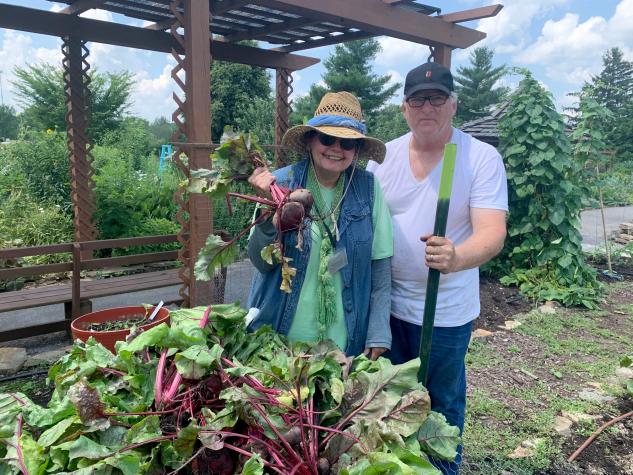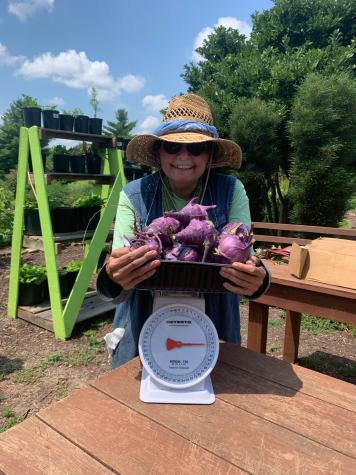SPRINGFIELD, Mo. – Those who have planted gardens feel that they have “done something for the good of the whole world,” wrote American author Charles Dudley Warner in 1871.
For Greene County Master Gardeners Maryfrances DiGirolamo and James Hilburn, gardening has become a way to give back to their community, doing “something for the good of the world.” They use their University of Missouri Extension Master Gardener training to oversee a vegetable demonstrations garden at Nathanael Greene/Close Memorial Park inside the Springfield Botanical Gardens.
“They donate all the produce they grow to local food pantries,” said Kelly McGowan, coordinator of Master Gardeners of Greene County. “Our group of volunteers who work up there take time to speak with visitors and answer questions too, so it is just a great educational tool for how people can grow their own food. And that is really important in a big urban area like Springfield.”
Last year, Greene County Master Gardeners donated more than 1,800 pounds of produce to local food pantries. This year, Hilburn and DiGirolamo have raised 1,250 pounds of produce as of Aug. 4 for Well of Life Food Pantry. And the two are still “growing” strong. Hilburn and DiGirolamo grow gardens at their respective homes, donating that produce to local pantries as well.
“Being able to donate food to the food pantries is one of the drives that keeps Maryfrances and I going,” Hilburn said. “We know that the food we turn out is going somewhere where it’s needed.”
Indeed, DiGirolamo knows firsthand the produce she drops off three times a week goes somewhere it's needed. When she's not volunteering with Master Gardeners of Greene County, DiGirolamo helps out at Well of Life, making lunches and gathering boxes of various food items for the less fortunate of Springfield.
As an advanced certified Master Gardener and chair of the vegetable garden, DiGirolamo puts together weekly tasks the pair must complete to keep the garden in top shape. Responsibilities include planting, watering, removing weeds (or “plant bandits,” as DiGirolamo describes them), harvesting, cleaning produce, weighing produce, recording statistics in their garden journal, and packaging produce to deliver to Well of Life.
“We've got the Kennebec and Pontiac potatoes, three kinds of carrots, white onions, red onions, green beans, sweet peas, okra, turnips, mustard, kale, purple turnips, yellow squash, zucchini, radishes, tomatoes, eggplant, cucumbers, arugula, lettuce, Romaine, beets, pole beans, snap beans, Jubilee watermelon, parsley, hot pepper, and then sweet peppers,” Hilburn said.
But that’s not all. Add cabbage, spinach and herbs to the list, DiGirolamo said. While volunteers at the garden have been unsuccessful growing mushrooms the past couple of years, DiGirolamo and Hilburn are hopeful this is the year they add the antioxidant-filled fungi to the garden.
“We try to touch upon everyone that comes to visit, helping them understand that it's not easy to grow crops,” said DiGirolamo, who has been volunteering with the demonstration garden for nine years.
“It sometimes takes a lot of failures before you become successful,” she said. “You need those failures to learn the ongoing curriculum in the garden. You become a better gardener because of that.”
McGowan, who is also a horticulture specialist for MU Extension, said volunteers have been managing the vegetable demonstration garden for more than 30 years.
“It was actually one of the first gardens inside the botanical gardens way back when it got started,” McGowan explained. “The vegetable demonstration garden was something our Master Gardeners wanted to do to show people how they can grow their own food.”
DiGirolamo and Hilburn oversee more than 10,000 square feet at Nathaniel Greene-Close Memorial Parks. And while it may be a bit of work to keep up with that much square footage, they agree it's a rewarding use of their time in retirement.
Both Hilburn and DiGirolamo previously worked in the medical field, and they understand the mental and physical benefits gardening can offer volunteers and visitors. Hilburn was a doctor in public health and DiGirolamo worked in diagnostic cytopathology, specializing in virology.
“Gardening is outdoor therapy at its best,” Hilburn said. “Between the birds and the vivid colors in the garden, the guests that come to the park walk through happier sorts of people. And our volunteers are like that. We are working hard, but we are laughing as we pass by each other. And it's a neat thing.”
DiGirolamo has noticed gardening can also provide individuals with a sense of accomplishment and security during uncertain times.
“I believe the global pandemic seems to have led to an increased interest in gardening across the country,” DiGirolamo said. “By talking to various visitors in the vegetable demonstration garden, I sincerely feel they discover the universal joys of working with their hands and seeing the results of their work grow and thrive.”
For more information on how you can become involved in the Master Gardener Program, visit mg.missouri.edu. A virtual version of the Fall 2020 Master Gardener program begins in August. Registration deadline for the fall online course is Aug. 16.
Photos available for this release:
Maryfrances DiGirolamo with 12 pounds of kohlrabi
Maryfrances DiGirolamo with 12 pounds of kohlrabi harvested this past July. Photo provided by Kelly McGowan.
Maryfrances DiGirolam) and James Hilburn
'Maryfrances (DiGirolamo) and James (Hilburn) are the ones that have the vision and the drive to do this,' said MU Extension horticulturist Kelly McGowan. 'They are sharing what they've learned with others and I am just really, really proud of them.' Photo provided by Kelly McGowan.
Writer: Ashley Craft

